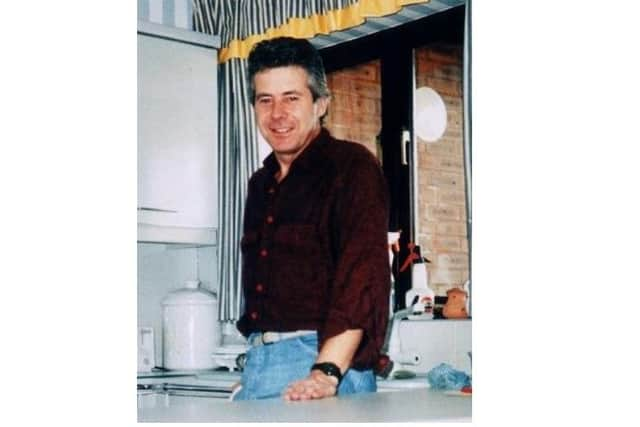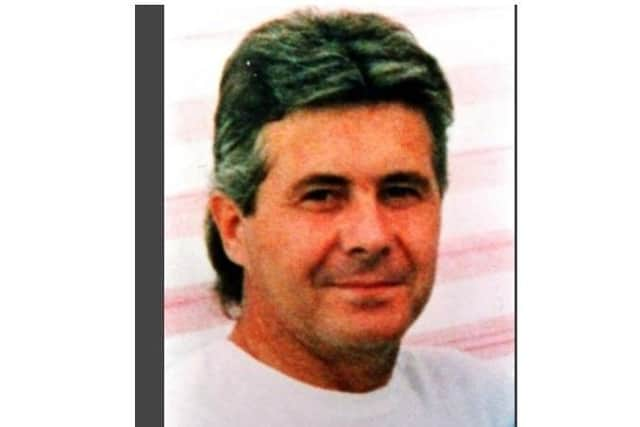True Crime: Portsmouth killer Victor Farrant was Britain’s most notorious fugitive after 1996 murder
and live on Freeview channel 276
The Portsmouth labourer drowned the 45-year-old mum of three, who was his ex-girlfriend, under water in the bath after demanding sex. Farrant claimed she simply slipped in the bath and banged her head. Farrant, 46 at the time, then hid her body in the attic before fleeing the scene. Mrs Hoskins' 15-year-old daughter later found her mother's corpse wrapped in carpet in the loft of her Sennen Place home.
After the murder, Farrant, who lived in London Road, North End, took off in Mrs Hoskins’ car before driving along the south coast while stopping off to sell items he had stolen from her house. The killer then fled to Europe where he stayed in Brussels whilst moving on frequently.
Advertisement
Hide AdAdvertisement
Hide AdPrior to the killing, Farrant was jailed for 12 years in 1988 for raping a woman and causing her grievous bodily harm as well as attacking another female with a bread knife. He met Mrs Hoskins on day release from prison in 1993 before his release from behind bars in 1995.


Just a month after his release on December 27, 1995, Farrant went to visit sex worker Ann Fidler in Eastleigh before attacking her with bottles and an iron. The attack was so ferocious she was left with partial brain damage and no memory of the incident. She needed a blood transfusion and was in a coma for over two weeks with doctors saying she was lucky to be alive. Farrant, known as a ‘charmer’ then picked up his relationship with Mrs Hoskins, who was separated from her husband. But the relationship did not last and she started seeing other men. Farrant was possessive and started stalking her before murdering her.
READ NOW: Glass attack
THE HUNT FOR FARRANT
Posters and information were sent to all police forces throughout Europe as Hampshire police launched one of its biggest ever manhunts to find Farrant, who had fled Britain.


Farrant had four sisters who lived in the Portsmouth area, but they had not heard from him. A detective said at the time: ‘His family is genuinely shocked and very sorry about what happened to Glenda Hoskins and Ann Fidler and would like him to give himself up.'
Advertisement
Hide AdAdvertisement
Hide AdHe gave Belgian authorities the slip in Brussels after taking a friend's car. Police appealed through The News for Farrant to give himself up.
Police then investigated claims he could be hiding in Spain. The new lead was the result of a national television appeal for information broadcast on Crimewatch UK.
Police made direct appeals to Farrant to give himself up as 10 women across Britain were under police protection - with four of those frightened women living in Portsmouth.
Farrant was finally found after a British tourist recognised him. On returning to the UK the tourist notified police that Farrant was working at a hostel in Nice, France. On July 5, 1996, an international arrest warrant was issued, and Farrant was arrested in the south of France by French police, and detained.
Advertisement
Hide AdAdvertisement
Hide AdBut it wasn’t until January 31, 1997, that Farrant was extradited to Britain and was flown into Southampton Airport with officers from Hampshire police. The force said they were powerless to speed up the extradition process and said the matter was out of their hands.
During the hunt for Farrant, The News spoke to Mrs Hoskins' best friend Karen Mitchell who said how the pair frequently met at nightclubs with Mrs Hoskins won over by his charm. She said: `He always looked smart and was a real smoothie.'
After his capture, The News revealed Farrant flirted with a string of international travellers while managing a French hostel and even warned women not to go out alone at night because it was not safe.
Farrant confirmed his reputation as a ladies' man during his time in Nice on the French Riviera, The News established after a reporter flew out to the location.
Advertisement
Hide AdAdvertisement
Hide AdStaff and guests at the hostel spoke of Farrant's friendly and helpful approach, and were stunned when shown a copy of the newspaper which broke the news of his arrest.
The owner of the hostel said: `I am stupefied. I cannot understand that he is accused of killing someone. He is a gentleman, and was all the time ready to give good service.’
COURT TRIAL
In January 1998, at Winchester Crown Court, Farrant pleaded not guilty to murdering Mrs Hoskins and not guilty to the attempted murder of Mrs Fidler.
During the trial, the jury heard extensive forensic evidence which included semen matching the defendant's DNA profile being found on his victim’s body. Blood matching his profile was also found at Mrs Fidler's house. His finger and palm prints were found on weapons which she was attacked with. Farrant was found guilty of both offences by jurors.
Advertisement
Hide AdAdvertisement
Hide AdOn January 29, 1998, judge Mr Justice Butterfield said the murder of Mrs Hoskins was ‘a ruthless, callous and evil act’.
The judge said the murder of Mrs Hoskins was a crime that was ‘planned, premeditated and committed in cold blood’ with Farrant not prepared to tolerate rejection.
The judge called Farrant a ‘highly dangerous man’ who had shown no remorse. ‘You have devastated the lives of many other people. The opportunity to do so again should not be allowed to you,’ the judge said.
‘This murder was so terrible and you are so dangerous that in your case the sentence of life imprisonment means just that. You will never be released.'
Advertisement
Hide AdAdvertisement
Hide AdFarrant was jailed for life for Ms Hoskins’s murder and given a further 18 years for the attempted murder of Mrs Fidler.
Ms Fidler, by then Mrs Ann Markham, was awarded £167,000 compensation having claimed £600,000.
POST TRIAL
Children of Mrs Hoskins spoke for the first time about the night of the killing and its effect on their family in the weeks after the sentence. They revealed how detectives had to separate Katie and David Hoskins and their father Tony within hours of the discovery of Mrs Hoskins's body. They were taken to individual rooms at a police station and interviewed.
They told The News: ‘We never thought he was that evil. We knew he was being possessive and would not take no for an answer. I thought he may have been round and then gone off and killed himself or something but we never thought he was a psychopath.’